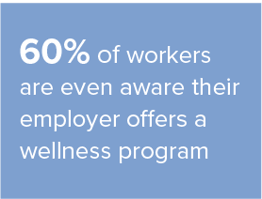
As the heat of summer approaches, every good gardener knows the seeds they planted in the spring require constant nurturing and attention—not just to survive, but to flourish. Corporate wellness programs are no exception: They require attention, work, and the proper resources to really succeed.
To reap the benefits of a robust wellness program—from decreasing absences to increasing productivity and improving overall health—it’s critical to promote your wellness program to create awareness and keep employees actively involved.
With so many demands on our time and attention, it’s not surprising that employees don’t always participate in employer-sponsored wellness activities. In fact, only 60% of workers are even aware their employer offers a wellness program, and just 40% of that group actively uses their wellness benefits.
So what approaches can you take to get—and keep—employees revved up about health and wellness? Here are 11 ways program directors can promote wellness programs to ensure they stay top of mind.
1. Advertise
 What good is a great wellness program if employees don’t know anything about it? Make the wellness program a constant feature in your company’s environment by displaying upcoming events, wellness program information, and employee successes in common areas.
What good is a great wellness program if employees don’t know anything about it? Make the wellness program a constant feature in your company’s environment by displaying upcoming events, wellness program information, and employee successes in common areas.
Wellness directors can also post educational signs about the big impact that little changes can have. Near the elevators, let employees know they can burn around 10 calories for each flight of stairs they take, compared with one or two for taking the elevator. By the cafeteria, show 100 calories of chips next to the same caloric amount of vegetables.
2. Capture Attention
Use a consistent, positive tone in your communication. Friendly, conversational messages that focus on the benefits of participation will be more well-received than those that sound critical in nature.
Another way to capture attention is to use lively and colorful graphics on program materials, helping associate the wellness program with fun activities and positive results.
3. Keep Messages Simple
There’s no need to be long-winded about the benefits of participating in your wellness program promotion. Short, positive messages—like a quick email, text, or calendar reminder to remind employees of an event or activity—are more effective at capturing employees’ attention.
4. Use the Power of Storytelling
Ever read a well-told success story and think, “If they can do it, I can, too!”? Leverage the power of storytelling to share how colleagues have used the wellness program’s services to improve their physical, social, emotional, or overall wellness. At the end of each story, encourage readers to share their own journeys.
5. Target Hard-to-Reach Employees
Employers who offer only mid-day learning sessions on wellness topics lose the attention and participation of third-shift workers. And remote workers won’t be able to take advantage of the monthly healthy cooking demonstrations you’re holding in the cafeteria.
Find ways to involve these harder-to-reach employees, like hosting offsite yoga sessions or weekend cooking classes, and then communicate with them during times that correspond with their work schedules.
6. Communicate Effectively
Develop a well-thought-out communication and wellness program promotion strategy, and then stick to it. Consider:
- The right channels for communication. Will a private Facebook group, an emailed newsletter, or a prominent section on your intranet’s home page work best?
- The frequency of communication. Are weekly updates too much? Are monthly updates too infrequent?
7. Encourage Wellness Program Diversity
Employers who define wellness as strictly physical health—and then create only physical challenges for employees to engage in—miss out on valuable opportunities to impact health and engage employees. Instead, consider other roadblocks to wellness, like burnout and financial stress, and address those issues in employee communications and challenges.
8. Be Consistent
When employees know Wellness Wednesday happens every week, or Meal Prep Monday is always the first Monday of the month, they’re more likely to remember and attend.
9. Keep Wellness Programs Relevant
If most of your employees are nonsmokers, a smoking cessation plan—while beneficial—will never achieve high program engagement. Survey employees to see what their wellness concerns are and adapt your program accordingly. Living, breathing programs that stay relevant to an employee’s concerns are the ones that keep participants interested and committed.
10. Hold Frequent Challenges
 A great way to keep wellness on employees’ minds is by holding challenges throughout the year that appeal to a broad range of employees. These challenges shouldn’t be just physical; instead, they can include emotional (e.g., complimenting three people daily), financial (e.g., saving $10 weekly for holiday gifts), and occupational (e.g., taking one online training class monthly) tasks.
A great way to keep wellness on employees’ minds is by holding challenges throughout the year that appeal to a broad range of employees. These challenges shouldn’t be just physical; instead, they can include emotional (e.g., complimenting three people daily), financial (e.g., saving $10 weekly for holiday gifts), and occupational (e.g., taking one online training class monthly) tasks.
11. Offer Usable Giveaways
Sometimes, all it takes is a little incentive to keep wellness on employees’ minds. If you’re encouraging employees to drink more water and less soda, give away reusable water bottles with your wellness program logo. Using it every day may help encourage the healthy behavior and inspire employees to make other changes.
Get Expert Help to Drive Wellness Program Participation
Without employee engagement and excitement, your employee wellness program just won’t thrive. But by implementing some of these 11 wellness program promotion tips, you’ll be able to promote your program, generate buzz, and keep employees interested in your wellness efforts.
And when employees are excited about what they and your company are doing to improve their overall health, they’re more likely to make other healthier decisions and engage in more activities that promote lasting change and have a positive impact.
Executing these strategies is easier when you have a dedicated team of experts with a passion for health and the resources to help you achieve your wellness program goals. Contact a WellRight strategist today to learn why we’re a trusted wellness resource for companies of all sizes and industries.





